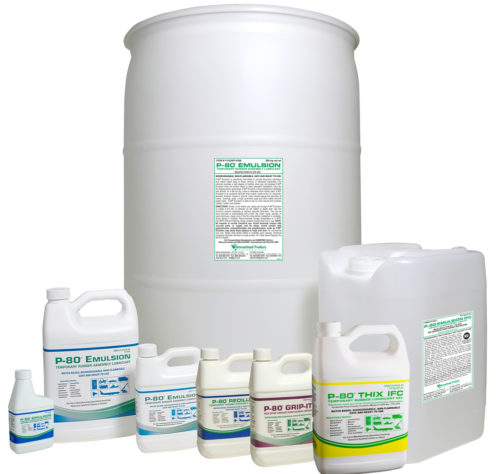What’s The Proper Way to Handle and Store P-80® Lubricants?
Tweet
 Print
Print
P-80® temporary rubber assembly lubricants decrease the installation force needed to install rubber parts, enabling them to slide easily into place. These lubricants provide a high degree of lubricity when wet, but once dry the slipping action goes away. P-80 lubricants are used throughout the automotive, appliance, pump, aerospace, bus & truck, wire & cable, heavy equipment, agriculture, rail, and marine industries.
All P-80 lubricants are environmentally friendly, non-hazardous and non-flammable, making them safe for workers and most plastics, rubbers and metals. But, as with any product, it’s important to follow proper procedures for usage, handling and storage.

P-80 storage and handling guidelines:
Storage conditions:
- Store P-80 at temperatures between 2°C – 30°C (36°F – 86°F)
- Do not store outdoors in direct sunlight during warm weather
- Store in original sealed container when not in use
- Do not allow P-80 to freeze
- Use oldest material first for proper inventory control
- Use the lot number to determine the date of manufacture
Usage instructions:
- Check for compatibility with your assembly materials
- When dispensing P-80 Emulsion, P-80 Emulsion IFC and P-80 RediLube
- Shake or stir before use
- Use a recirculation pump or folding propeller mixer for drums and totes
- Do not use air agitation to mix P-80
- P-80 is packaged ready for use, do not dilute
- Use a dedicated pump for dispensing and mixing
- Do not pour dispensed product back into the original container
- Do not add fresh P-80 to used P-80
- Do not mix P-80 with other chemicals
- Apply a thin film of P-80 to the rubber/plastic part
- Use either an automatic or manual application method best suited to your specific needs
- Dip/dunk
- Brush
- Spray
- Sponge
- Squirt
- By hand, with gloves
- Work area and equipment should be cleaned after each use
- Excess P-80 can be wiped away with soap and water
Preventative Maintenance
- All equipment should be thoroughly cleaned and sanitized at least once a month
- Cleaning frequency should be adjusted based on the following:
- Temperature of the work environment
- Cleanliness of the plant
- Frequency and length of downtime
Once a preventative maintenance program is established, the system will remain effective and problem free.
Set yourself up for success! Follow these simple guidelines for use and discover how P-80 can ease your rubber assembly applications. P-80 is classified as non-hazardous according to GHS, making it safe for workers and the environment. In fact, most P-80 formulas are biodegradable. Refer to the individual product SDS’s and the P-80 standard operating procedures for more details.
Learn more about P-80 lubricants here. Or contact one of IPC’s technical specialists for assistance.

Tweet
 Print
Print